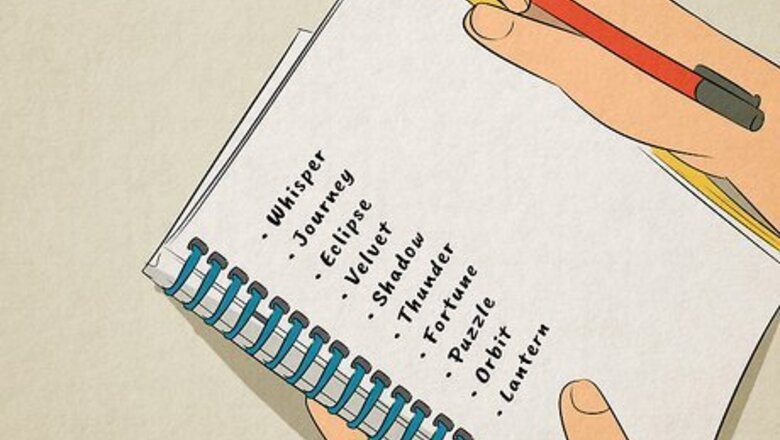
views
Password Game Setup
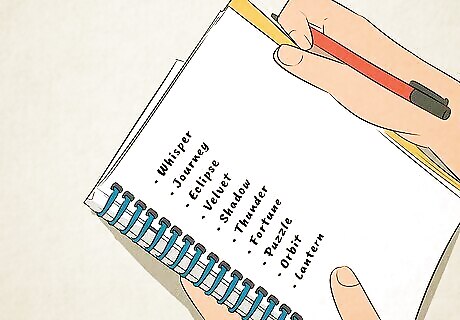
Create or generate a word list. If you’re playing the board-game version of Password, skip this step—the game comes with cards that have words printed on them already. If you’re playing without the board game, use an online word generator or think of your own creative password ideas. Passwords must only be one word—no hyphenated words like self-esteem or mother-in-law. In the classic version of the game, you can’t use proper nouns, aka specific names for people, places, and things. For example, you couldn’t use a name like “Beyonce” as a password. It’s up to you if you want to follow or ignore this rule. If you’re playing in an educational setting, create a word list of vocabulary, historical figures, or other important concepts.
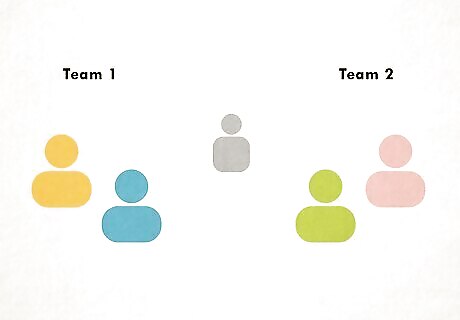
Divide four players into two teams of two. Each team member takes turns being the clue-giver and the guesser, so everyone plays every role. Have all players partner up with one other person. Alternatively, assign teams randomly and try to split up people who know each other well to make the game more difficult. If you have more than four players, have teams take turns going head-to-head, two at a time, for a predetermined number of rounds.
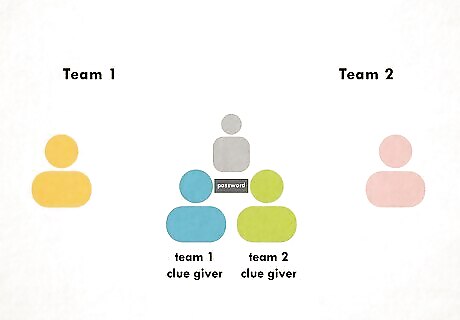
Assign the first clue givers and have them sit next to each other. The clue givers in Password must sit next to each other so they can read the secret password for that round together, without showing it to their teammates. Have the guessers sit across from their clue-giver teammates.

Randomly choose a team to give the first clue. Either draw straws and have the long straw go first, roll a die to see which team gets the higher number, or base it on who has the earliest birthday on the calendar. Whatever method you choose, make sure everyone knows which team will give the first clue (and guess). In future rounds, have the team that went second last time go first. There are advantages to going first and second. Going first might let you give a clue that lets your teammate guess correctly without the other team having a chance. However, going second means you have the benefit of hearing two clues before guessing.
How to Play Password

Have the first clue-giver offers a one-word clue. Pretend the secret password is “mouse.” This is a good password because it could refer to either a rodent or the mouse used on certain computers, so there are different types of clues you can give. Because mice stereotypically like cheese, the first clue-giver might provide the one-word clue, “cheese.” Clues can’t be repeated within one round, rhyme with the password without being related to it, or abbreviate the password. However, you can use proper nouns as clues. You can’t use charades or gestures to indicate what the secret password is, but you can use vocal inflections and facial expressions to help the guesser.
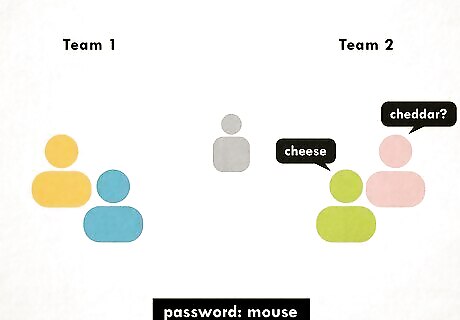
The first guesser then tries to guess the password. If they’re lucky, they make the association between the clue and the secret password and get it correct—in this example, guessing “mouse.” If they make an incorrect guess, like “cheddar,” the clue-giver announces that they’re wrong. After the guess, gameplay proceeds as follows: Correct guess: The team that guessed correctly receives 10 points for guessing the answer from the first clue. Incorrect guess: The second team has a chance to give a clue and make a guess for a chance to receive 9 points. To speed gameplay, give guessers 30 seconds to make a guess.

Gameplay continues until the password is guessed or 10 clues are given. The two teams go back and forth after each incorrect guess, with the clue-givers offering new clues and the guessers trying to figure out the secret password. If 10 rounds pass by without someone guessing the password, the clue-givers reveal the password and neither team gets a point. Gameplay stops after 10 rounds because each time a new clue is given, the points the winning team receives go down by 1. A correct guess after the first clue is worth 10 points, after the second clue is worth 9 points, and so on. A correct guess after the tenth clue is worth one point—it’s that team’s last chance to win the round!
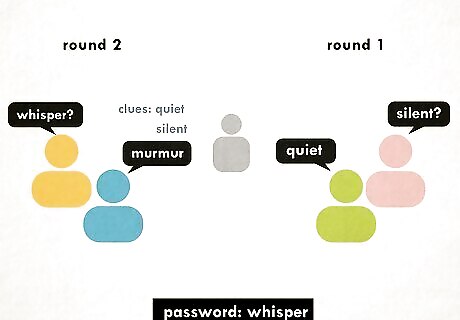
After five rounds, the team with the most total points wins. Have someone keep track of the points each team has as you play, either by writing it down on paper or typing it into the Notes app on their phone. Once five rounds are up, declare the winning team based on whoever has the highest point total. A perfect score is 48 (if your team goes first in three rounds) or 47 (if your team goes second in three rounds). However, it’s unrealistic that a team would get the secret passwords on the first or second clue every round. If you’re playing with more than two teams, consider doing an elimination-style tournament: Each round, the losing team is eliminated. The winning teams from every two rounds face off. Eliminations continue until only two teams remain. The final round decides who wins the entire game.
Strategies to Win Password
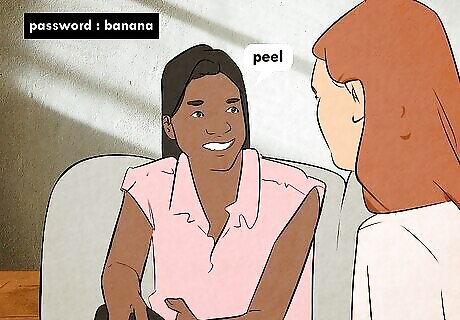
When giving clues, use specific words to narrow down options. For example, if the secret password is “banana,” “fruit,” “peel,” and “yellow” are helpful clues. Monkeys like bananas, but saying “monkey” might lead your guesser in the wrong direction.

Offer clues relevant to you and your teammates’ interests. If you know the person you’re giving clues to, try to use references you know they’d get. Not only does this increase the chance they’ll make a correct guess, but it prevents the other team (who hears all your clues and guesses) from getting extra help. For example, if the password is “basketball” and you know your partner’s favorite team is the Lakers, you can use “Lakers” as a clue instead of a general one like “sport” or “hoop.”

As a guesser, remember all previous clues. The longer a round stretches on, the more confused you may feel while trying to guess the password. Take a pause before making a guess to consider the clues your teammate’s given and the clues from the other team. Try to detect a pattern or connection you’re missing.

Pay attention to the clue-giver’s facial expressions and voice while guessing. If they look shocked while giving a clue, it might indicate that the password has something to do with surprise, like a party. If they shout, the password could be related to something that makes a loud noise, like an instrument, or an action like yelling.
Password Game Variations to Try
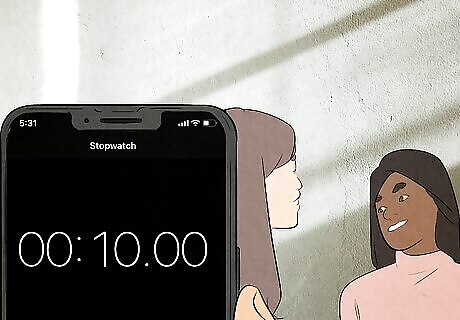
Lightning Rounds Use a timer to limit how long the guessers have to guess the password after hearing the clue. While the classic game gives players 30 seconds to submit a guess, make the game more chaotic and challenging by giving guessers only 10-20 seconds. Consider placing a similar time limit on clue-givers for a super-fast lightning-round version of Password.

How Well Do You Know Me? When creating your password list for the game, bend the rules by choosing a mix of proper nouns and words related to each player. Keep the rest of the gameplay the same. Give each clue-giver the list of passwords related to themselves so they can offer clues and see how well their partner knows them. For example, say one of the passwords is the university the clue-giver attended. They might give clues like “college,” “alumni,” or the state or city the college is located in. This variation is great for birthday parties, family game nights, and bridal or baby showers.

Picture Password Combine Password with Pictionary to form a hybrid game that uses either printed pictures or whiteboard sketches as clues. Since both teams have the same secret password, they can either work on one drawing together or make separate drawings that only their teammates see.
Password Game Word List
Choose a mix of easy and difficult passwords from this list. Coming up with passwords to use can be difficult. You want words that are guessable, but not obvious or too obscure. For any game, you’ll need at least five passwords, but it helps to have more in case a team finds a password too difficult to use. Food and drink passwords: apple, potato, pancake, soup, pizza, spaghetti, chicken, popcorn, toast, strawberry, soda, water, juice, fish, chocolate, bacon, grapes, nuts, lemon, pickles, shrimp, cookie Object passwords: tuba, car, paper, shoe, fork, fire, couch, magazine, perfume, necklace, ring, table, house, television, game, dress, envelope, toothpick, tape, crayon, pinecone, plate, jeans, menu, island Animal passwords: bear, turtle, dog, cat, zebra, giraffe, elephant, lion, cow, wolf, spider, deer, monkey, fox, gorilla, kangaroo, rhinoceros, sheep, camel, koala, tiger, hippopotamus, snake, porcupine, ostrich, alligator, beaver, frog, lizard To create difficult passwords, think of words that have multiple meanings or represent abstract concepts. For example, while most people know directions, they might have a hard time guessing the password “North.” Another example is “bat,” which could refer to the winged animal or a baseball bat.
Use a random word generator to get more passwords. Using a random generator ensures that the words won’t be biased toward subjects you know. Search for random word generators like this one. Fill out the field with a number, depending on how many passwords you’d like to create. Hit “Generate” and review the words to decide which ones are usable.

















Comments
0 comment